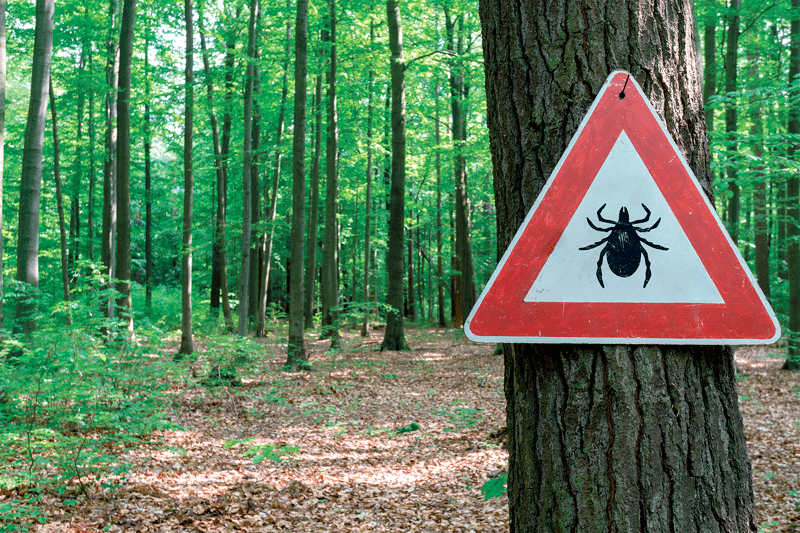Tick-lish Subject – It’s Another Bad Season, but Tick-borne Illness Can Be Prevented
According to the Centers for Disease Control and Prevention (CDC), Americans may contract up to 30,000 cases of Lyme disease each year, yet only 3,500 cases are diagnosed.
That’s a lot of undetected bites. And it doesn’t have to be the case, said Dr. J. Michael Klatte.
“Ticks must be attached to the skin for at least 36 to 48 hours before they are able to pass along bacteria to humans that can cause infections like Lyme disease and anaplasmosis,” said Klatte, a pediatric infectious disease specialist at Baystate Children’s Hospital.
The CDC recently reported that illnesses transmitted by blood-feeding ticks and insects capable of transmitting pathogens — bacteria, viruses, or parasites — from one host to another have more than tripled nationwide, from 27,388 cases in 2004 to nearly 100,000 cases in 2016. This year’s projections were equally dire.
Yet, “we hear that prediction almost every year now, but it’s nothing to be overly concerned about if you are ‘tick-smart,’” Klatte said.
Ticks make their homes in wooded or grassy places and stealthily attach themselves to the skin of humans and animals, transmitting diseases such as babesiosis, anaplasmosis, Powassan disease, and the most common tick-borne disease, Lyme, which is commonly spread by deer ticks.
But people who are diligent about making those tick checks when they return indoors after being out in wooded and grassy areas — while playing, gardening, hiking, camping, or any of a host of other activities — don’t need to fear the onset of these diseases, Klatte noted.

“Check clothing for any visible signs of ticks; then, as an additional precaution, you can tumble them in the dryer set to high heat for at least 10 minutes before throwing them in the wash,” he explained. “Showering in warm water can also be a good way to gently wash off unattached ticks that have made it from clothing to you or your child’s skin. You don’t want to vigorously scrub the skin and risk breaking in half a tick that might have become embedded in the skin.”
In addition, “while children are undressed, it’s a good opportunity to check their bodies for any sign of an attached tick. Checking your own body may be a little more difficult and require the use of a mirror, unless you have a partner who can check for you.”
Tick ‘hot spots’ to check include under the arms, inside the bellybutton, behind the knees, in and around the ears, the waist and back, the pelvic area, and between the legs.
If these checks do reveal a tick on the skin, the CDC offers the following tips on how to remove the insect:
• Use fine-tipped tweezers to grasp the tick as close to the skin’s surface as possible;
• Pull upward with steady, even pressure. Don’t twist or jerk the tick, which can cause the mouth parts to break off and remain in the skin. If this happens, remove the mouth parts with tweezers. If you are unable to remove the mouth easily with clean tweezers, leave it alone and let the skin heal;
• After removing the tick, thoroughly clean the bite area and your hands with rubbing alcohol or soap and water; and
• Dispose of a live tick by submersing it in alcohol, placing it in a sealed bag or other container, wrapping it tightly in tape, or flushing it down the toilet. Never crush a tick with your fingers.
Economic Costs
Laurie Johnson, executive director and co-founder of the Climate Cost Project in Amherst, said increased rates of Lyme disease have been linked to climate change, and are one of the more serious and least understood of its costs.
“We know very little about uninsured costs people across America are experiencing from climate-change impacts,” she said. “Having seen friends and families devastated both personally and financially by Lyme disease, we felt it was important to start understanding the real costs of the disease to individuals.”
She added that, because insurance typically covers little to none of patients’ treatment costs, experts have no idea how much the disease actually costs individuals and society. But between medical treatment and lost work time, Johnson notes they can easily add up to hundreds of thousands of dollars in healthcare expenses and lost income.
“Right now, Lyme disease is highly regional, with 14 states in the Northeast and upper Midwest accounting for 95{06cf2b9696b159f874511d23dbc893eb1ac83014175ed30550cfff22781411e5} of confirmed cases,” Johnson said, noting that the disease is starting to spread rapidly, with ticks carrying Lyme disease in almost half of all counties across the country.
With few treatment options, and so few covered by insurance, patients are left on their own to find alternative treatments and pay for them, she said.
Johnson cited the story of a long-time Amherst resident who contracted Lyme disease in 2006. A standard three-week course of antibiotics eliminated her classic flu-like symptoms at the time, but nine years later, new and more severe symptoms appeared, including debilitating joint pain, numbness, chronic exhaustion, and memory loss.
The woman tested positive again for Lyme in 2015. This time, her treatment took more than two years, and much of it was not covered by insurance. She estimates she spent anywhere from $10,000 to $20,000, but feels lucky that she could afford it, had plenty of sick time to cover missed work, and feels fully recovered.
“Unfortunately, that story is not unique,” Johnson said, explaining that preliminary data from a new survey on Lyme disease costs from the Climate Cost Project finds more than half of respondents spending at least $30,000. More than half also reported missing significant amounts of work.
By contrast, according to the Kaiser Family Foundation, average uncovered costs for some of the most expensive out-of-pocket conditions cap out at around $2,000 per year, she added.
“We’ve heard from patients and physicians across the country with stories like that, many significantly worse. We believe the data is just the tip of the iceberg,” said Sieren Ernst, CEO and co-founder of the Climate Cost Project. “Compared to other diseases, out-of-pocket spending may be orders of magnitude higher for tick-borne illness than other diseases. The more data we are able to get from the survey, the clearer the picture we will have.”
Ounce of Prevention
To avoid those health and economic costs, the best treatment for Lyme disease is prevention, Klatte said.
“If you or your children are going to be out hiking in the woods or playing in bushy or tall grassy areas, dress in long-sleeved shirts and long pants, a hat, and use an insect repellent that contains at least 20{06cf2b9696b159f874511d23dbc893eb1ac83014175ed30550cfff22781411e5} to 30{06cf2b9696b159f874511d23dbc893eb1ac83014175ed30550cfff22781411e5} DEET as additional protection. For those concerned with the chemicals found in insect repellents, there are some natural alternatives available, including oil of lemon eucalyptus, which is approved for kids 3 years and older, and others made with natural plant oils.”
If illness develops within a few weeks of a tick bite, seeing a doctor is recommended immediately, he added. Symptoms of Lyme disease that develop within the first month following a deer-tick bite can include one or more rashes which may or may not resemble a classic bullseye, heart problems, meningitis, and/or facial palsy (a loss of muscle tone or ‘drooping’ of one or both sides of the face). Occasionally, patients are seen with later manifestations of the disease, which most frequently is swelling in a single joint — usually the knee (often referred to as Lyme arthritis).
Antibiotics can be used to treat both early- and late-onset Lyme disease. In certain situations, Klatte added, a dose of antibiotics can be given to children after a tick bite to help prevent development of Lyme disease.
According to the Mayo Clinic, a doctor should also be called if:
• You aren’t able to completely remove the tick. The longer the tick remains attached to your skin, the greater your risk of getting a disease from it;
• The rash gets bigger. A small red bump may appear at the site of the tick bite. This is normal. But if it develops into a larger rash, perhaps with a bullseye pattern, it may indicate Lyme disease. The rash usually appears within three to 14 days;
• You think you may have been bitten by a deer tick, or you develop flu-like signs and symptoms. Fever, chills, fatigue, muscle and joint pain, and a headache may accompany the rash;
• You think the bite site is infected. Signs and symptoms include redness or oozing.
After locating and removing a tick from the skin, Klatte noted, “the site will generally heal on its own. Medical attention should be sought if the tick bite site develops redness, swelling, or tenderness to the touch, which could be a sign of a secondary bacterial infection.”



Comments are closed.